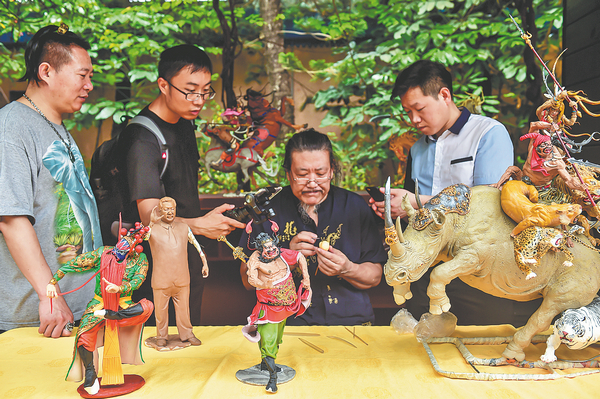

More efforts urged
At Beijing Wtown in the Chinese capital's Miyun district, traditional dyeing, paper-cuts, shadow plays, Peking Opera and movable type systems have drawn crowds of enthusiastic visitors.
Shi Shanfeng, assistant president of the water town resort, said, "These features enable our guests to experience the inheritance and development of intangible cultural heritage in China." Such experiences combine well with the Great Wall and other attractions in the area, Shi added.
More efforts should be made to enrich cultural experiences at the venue, Shi said.
In Wuhan, capital of Hubei province, Jiqing Street is home to intangible cultural heritage featuring distinctive food and craftwork that showcase the best of traditional and modern life and attract about 1 million visitors annually.
Food lovers line up outside the Sijimei restaurant, which sells dumplings with juicy meat on the street. The method of making these dumplings, which first appeared about 100 years ago, is a provincial intangible cultural heritage.
Zhang Dejuan, a fourth-generation inheritor of the dumping-making method, said the dough is as thin as paper, and the filling is made from 20 ingredients, including broth, diced chicken, pork, wine and dried shrimp.
Explaining the dumplings' popularity, Zhang said, "It's all about using good ingredients, precise cooking techniques, and understanding the subtle nuances."
In addition to choosing premium ribs and flour, the right time to add salt and ginger in the amount prescribed in the recipe is key to satisfying visitors' taste buds, Zhang said.
A short walk from the dumpling restaurant, the century-old Wangyuxia traditional bakery offers delicate local snacks and a tour of their history and culture at its own museum.
A handicraft fair is also a big attraction on Jiqing Street. Visitors watch sugar-blowing (an artform in which heated syrup is used to mold a sugar ball into different shapes), dough figurines being sculpted, and shadow puppetry and other examples of intangible cultural heritage by folk artists. Related souvenirs are also available.
The stall of Liu Jie, an inheritor of dough sculpting, is always surrounded by curious visitors who watch Liu fashion figurines, flowers and animals.
"These stalls at the fair provide some income for inheritors, but more important, they enable residents and tourists to come into close contact with intangible cultural heritage, bringing it fully into people's lives," Liu said.
In addition to local opera performances, various forms of traditional Chinese storytelling are staged regularly on the street.
Zhang Xilin, an official with the street management team, said, "The fair has proved to be a sensation."
The mix of intangible cultural heritage and tourism on Jiqing Street has been a success and is popular with visitors from home and abroad, Zhang said.
The street authorities are considering developing more cultural experiences and establishing intangible cultural heritage classes for student visitors.
"Adjustments will also be made to the selection of handicraft products at the heritage fair to attract more residents and tourists," Zhang added.